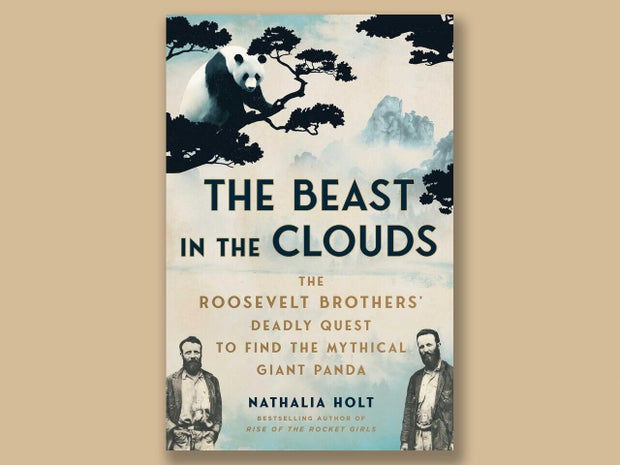 Atria/One Signal
Atria/One Signal
We may receive an affiliate commission from anything you buy from this article.
In the latest book by Nathalia Holt (the bestselling author of "Rise of the Rocket Girls"), two sons of Theodore Roosevelt set out for China on a quest to find a mythical creature: the giant panda.
"The Beast in the Clouds" (Atria/One Signal) recounts the brothers' treacherous trek, and examines the implications their expedition posed towards these gentle animals.
Read an excerpt below.
"The Beast in the Clouds" by Nathalia Holt
Prefer to listen? Audible has a 30-day free trial available right now.
Prologue
Two brothers smoothed a map on the table in front of them. The land they were examining was colored in greens, browns, and grays. Running across the map, like the stripes of a tiger, were irregular white blotches. Each blank space represented the unknown, a section of the map still unplotted and unexplored. The squiggly dotted line of a river, unknown printed in small text, cut through the white. It was 1928 and the world was still a checkerboard of wonder, the continents imperfectly mapped. Ted and Kermit Roosevelt, the two eldest sons of former president Theodore Roosevelt, were planning an adventure. Although they consulted maps from a diverse range of cartographers, including those drawn in China, the unexplored regions persisted. The vast Asian continent dappled with white spoke to them. The world was full of explorers, all examining maps like the ones the Roosevelts possessed. There was a heady, optimistic feeling that persisted among them. No one could be certain which mountain was the tallest on earth nor which trench in the ocean the deepest. Every expedition held the possibility of making its members world-famous explorers.
The 1920s were a decade of discovery, as groups of scientists, adventurers, and hunters ventured forth into the wilderness to fill museum collections. They were successful: every large mammal on earth had been attained, and their bodies mounted in exhibits, except for one.
The Roosevelts desired this one animal so acutely that they could barely speak about it with each other, much less anyone else. "We did not let even our close friends know," wrote Ted of their shared purpose. Some dreams sound too wild when spoken aloud. The animal the Roosevelt brothers coveted looked like no other species in the world. It was a black-and-white bear so rare that many people did not believe it was real. This legendary creature was called the giant panda. Rumors swirled about the mysterious animal. No one, not even naturalists who had worked in China all their lives, could say precisely where the creature lived, what it ate, or how it behaved.
Brown, black, and polar bears had never been in doubt among humans. Even polar bears, although living in the remote reaches of the Arctic, were well known, and had been kept in zoos for thousands of years. In Egypt, King Ptolemy II had a polar bear in his zoo in Alexandria as early as 285 BC. In 1252, a polar bear was part of the Tower of London's extensive menagerie of beasts.
Yet the same could not be said of the panda bear. Even among those living in the Republic of China, spanning some 7.7 percent of the earth's landmass, few had ever caught sight of the creature. Dozens of names were used to describe what might be a panda. In different dialects they called it "spotted bear," "giant bear cat," "white bear," and "bamboo bear," although no one could be sure that all these different names were referring to the same species. There were probable references to the giant panda in Chinese literature as early as the third century, although the descriptions were mythical, describing yellow-and-black creatures that munched on copper and iron. "While there are tantalizing stories implying that one Chinese emperor or another knew all about panda," wrote one author, "there's one great mystery. Why is there not a single rendition of this endearing beast in any of imperial China's illustrated natural histories?"
From "The Beast in the Clouds" by Nathalia Holt, published by Atria/One Signal, an imprint of Simon & Schuster. Copyright (c) 2025 by Nathalia Holt. All rights reserved.
Get the book here:
"The Beast in the Clouds" by Nathalia Holt
Buy locally from Bookshop.org
For more info:
- "The Beast in the Clouds: The Roosevelt Brothers' Deadly Quest to Find the Mythical Giant Panda" by Nathalia Holt (Atria/One Signal), in Hardcover, eBook and Audio formats
- nathaliaholt.com

 3 hours ago
4
3 hours ago
4







